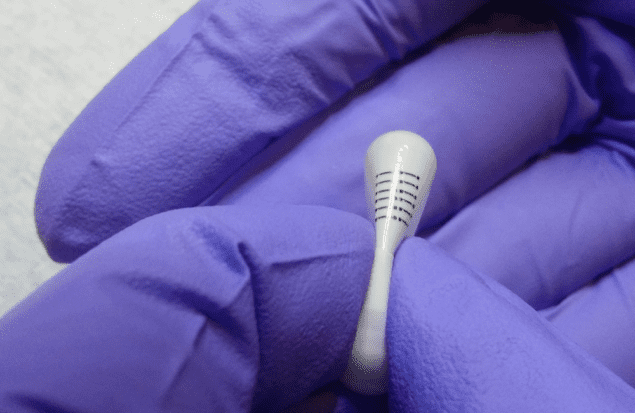
Edible electronic circuits have been made by modifying a technique for transferring temporary tattoos. The process was developed by scientists in Italy, South Korea and Japan who say that the transfers are completely ingestible – and could be used to create electronic tags that could be monitored as they travel through the body. The team has also shown how the circuits can be transferred to a range of edible items including fruit and drug capsules.
Ingestible electronic devices have great potential for medical treatment and point-of-care testing. They could perform diagnostic tests or control the release of a drug, and transmit data to healthcare professionals. Such technology could also have applications in the food industry, particularly for tracking and monitoring food as it moves through the supply chain.
Bitter pills
Most devices proposed so far have used large silicon-based electronics that are costly to produce, making them unsuitable for mass produced, single-use items. “Edible or ingestible electronics is typically approached by means of common silicon chips and bulky electronics, encapsulated in an ingestible pill (an inch long, typically),” explains Mario Caironi, at the Polytechnic University of Milan, in Italy. “Such a pill has to be evacuated from the body after its function.”
Writing in Advanced Materials, Caironi and colleagues say that tattoo paper – the paper used to create the temporary tattoos loved by kids everywhere – could offer a more functional approach. They say it is ideal for edible electronics as the transfers are made from ethyl cellulose, an ingestible material commonly used in medicines and as an emulsifier in food, and can be easily printed on.
Tattoo you
Temporary tattoos consist of a thin film of ethyl cellulose – which the design is printed on – stuck to a paper sheet with water-soluble starch or dextrin. To apply the tattoo, you soak the paper in water and place it on your skin and as the starch or dextrin dissolves peel the paper away, leaving yourself ‘tattooed’.
To test their idea, Caironi and colleagues used an ink jet printer – designed for printing electronics and displays – to print electronic circuits made of silver and mixes of four different semiconducting polymers on tattoo paper. They printed a range of transistors and logic gates, and transferred them on to drug capsules, strawberries and glass microscope slides.
“The tattoo releases a half-a-micron thick cellulose layer, which is edible, with our transistors and circuits printed on top,” says Caironi. “The technique is key to our proposed approach, as it decouples the printing – which can be potentially done on small scale – from the integration with edible items, which do not require any pre-treatment.”
Variable results
The effect of the transfer process on the circuits varied with different transistors, logic gates and polymers. In some cases, the effect on functionality was small, while for others there was a marked deterioration. The researchers put these issues down to impurities introduced when the circuits were exposed to air, light and water during the transfer process. They believe that adjusting the material mixes would create more stable circuits.

Integrating electronics with the human body
A key issue with ingestible electronics is biocompatibility. The team point out that the recommended dietary allowance of silver for someone weighing 70 kg is 350 μg. A single printed transistor contains around 4 μg of silver. Two of the polymers used – poly(3-hexylthiophene) and polystyrene – are known to be biocompatible, while the other two have only recently been developed and their toxicity is unknown. The researchers conducted some basic laboratory tests, with promising results, but say that dedicated studies will be needed to determine the biocompatibility of these materials.
Edible logic
Christopher Bettinger, from Carnegie Mellon University in Pittsburgh, in the US, says of the journal article describing the tattoos: “This is a really interesting paper that explores the interface of organic electronics, printing technology, flexible devices, and ingestible electronics”. He adds, “This technology adds to the growing list of materials, techniques, and manufacturing methodologies that are dedicated to increasing the capabilities of electronic devices that can be deployed to the gastrointestinal tract through the oral route”. “The transistors described here could be used as logic elements for ingestible sensors or smart controlled release devices. What remains to be seen is how these devices can perform stably in the potentially caustic environment of the stomach and small intestine.”
Caironi says, “We took a first step, demonstrating that we can transfer printed circuits on edible items”. “We have on the one hand to go deep in the assessment of edibility of the semiconductors. On the other, we have to progress at the system level, integrating our circuits with sensors, for different applications, with edible batteries and with a suitable communication system.”



